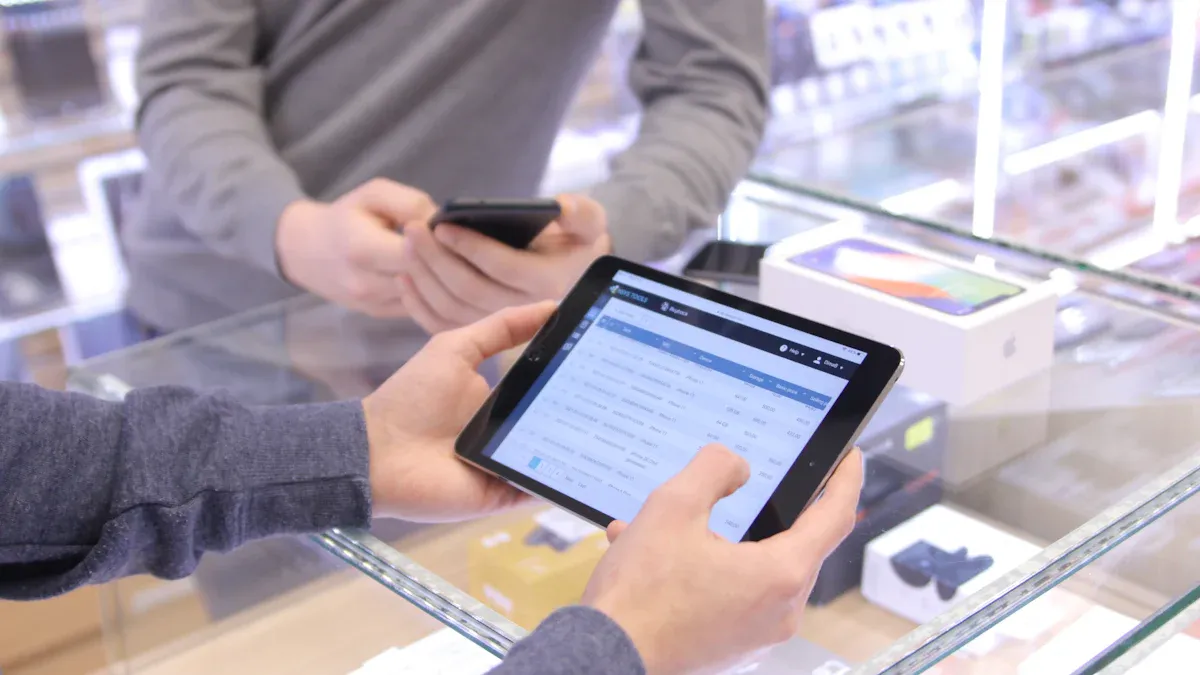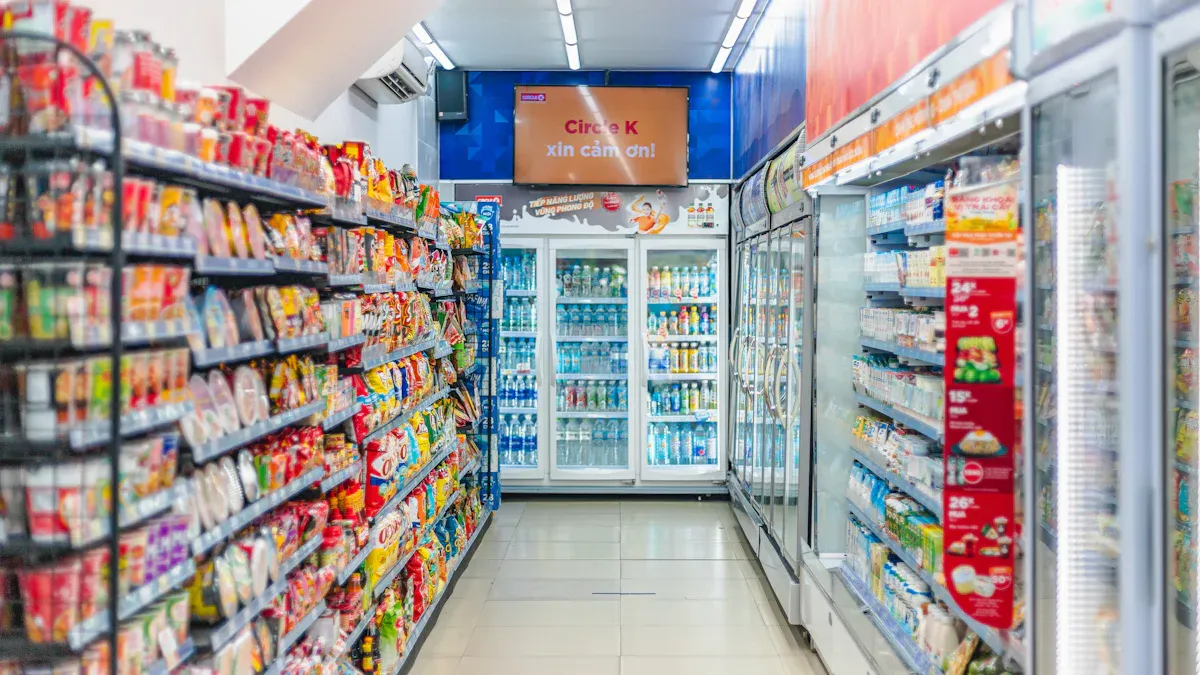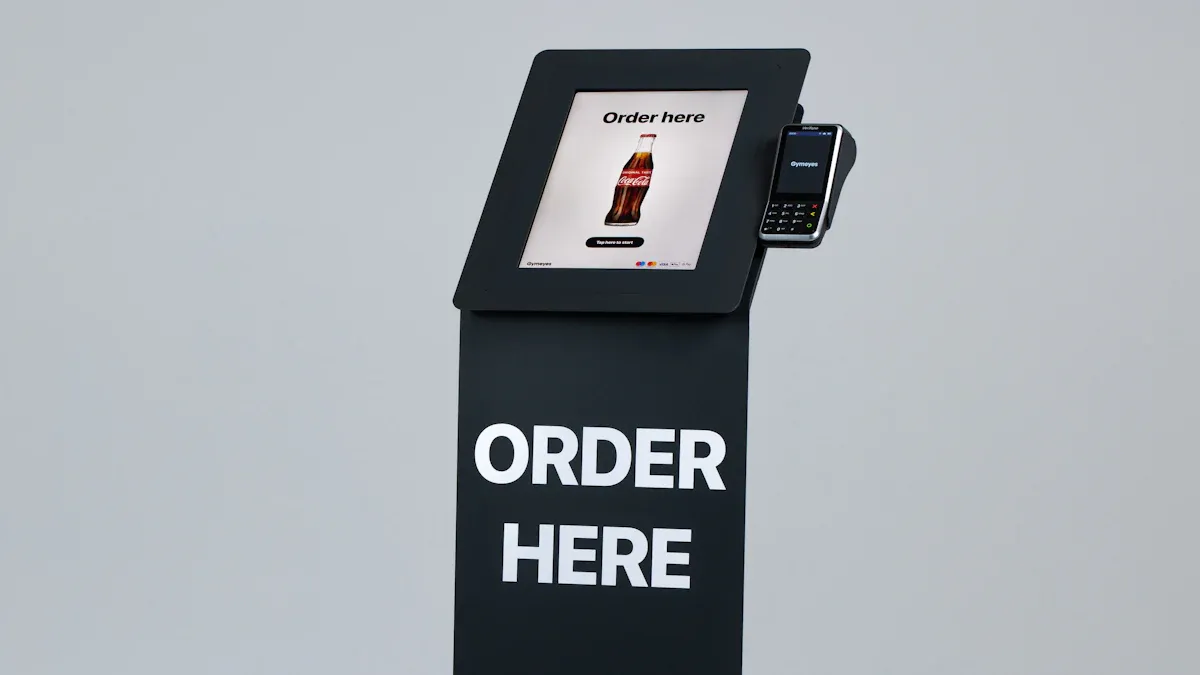How to open a profitable unmanned store

You can open a profitable unmanned store by following a smart six-step plan that uses the latest tech and automation. RFID systems, automated payments, and strong security help you keep costs low and make shopping easy. The global market for unmanned stores is booming, with experts expecting it to reach over $202 billion by 2029. Many people choose this business for flexible or part-time income, letting you earn money with less hands-on work.
Key Takeaways
Choose high-demand products like snacks and drinks to attract customers. Understand local preferences to stock items that sell well.
Utilize technology like RFID and automated payments to streamline operations. This reduces labor costs and enhances customer satisfaction.
Implement strong security measures to build trust with shoppers. Use AI surveillance and anti-theft devices to protect your store.
Select a prime location with high foot traffic. Areas near schools or busy neighborhoods increase visibility and sales.
Monitor performance and customer behavior using data analytics. This helps you make informed decisions about inventory and pricing.
Profitable Unmanned Store Essentials

Product Selection
Choosing the right products is the first step to building a profitable unmanned store. You want items that people need every day. Snacks, drinks, and personal care products work well. If you know your neighborhood, you can pick products that match local tastes. For example, if your area has many students, you might stock quick meals and school supplies. You can also look at what sells in nearby stores. This helps you avoid stocking items that do not move fast. When you focus on high-demand products, you make shopping easy for your customers and boost your sales.
Tip: Start small and test different products. Watch what sells best, then add more of those items to your shelves.
Market Demand
You need to understand what drives people to shop at unmanned stores. Here are the top three factors that influence market demand:
Convenience: People love shopping when it fits their schedule. Unmanned stores let them buy things anytime, even late at night.
Security and Trust: Shoppers want to feel safe. Reliable payment systems and clear privacy rules help build trust.
Price Sensitivity: Many customers look for good deals. Unmanned stores often have lower prices because they save on labor costs.
If you pay attention to these factors, you can attract more customers and keep them coming back. You make your store stand out by offering easy shopping, safe payments, and fair prices.
Inventory Management
Managing your inventory is key to running a profitable unmanned store. You need to know what is on your shelves at all times. Automated systems like AI, RFID, and computer vision help you track products and reduce losses. Here is how these technologies impact shrinkage rates:
Technology Used | Impact on Shrinkage | Description |
|---|---|---|
AI | Enhances monitoring and alerts for suspicious activities | |
RFID | Real-time tracking | Provides accurate inventory data |
Computer Vision | Continuous monitoring | Acts as a virtual patrol guard to prevent theft |
With these tools, you spend less time counting items and more time growing your business. You also cut down on theft and mistakes. This means you keep more of your profits and make your store run smoothly.
Technology and Automation

RFID Systems
RFID systems make your store run around the clock. You can track every item on your shelves with almost perfect accuracy. Customers love how fast self-checkout works. They scan and pay for goods using RFID tags, which means no waiting in long lines. You get real-time inventory counts, so you always know what needs restocking. Stores using RFID have seen their revenue go up by as much as 2.5% because they manage inventory better. The average return on investment for RFID systems is rising, from 11% in 2023 to nearly 20% by 2032. If you want your profitable unmanned store to stand out, RFID is a must-have.
Tip: RFID technology helps you keep your store open 24/7 and gives your customers a smooth shopping experience.
RFID lets you:
Offer fast self-checkout
Keep inventory counts nearly 100% accurate
Boost customer satisfaction
Automated Payments
Automated payment systems make shopping easy and quick. Most customers now prefer contactless payments. In 2024, 53% of all retail transactions used tap-to-pay, and 90% of big U.S. retailers accept it. Transactions process 44% faster than old methods, saving you up to 20 seconds per customer. You also cut labor costs by up to 70% because you need fewer cashiers. Self-checkout lets shoppers scan and pay for items on their own. Advanced security, like end-to-end encryption and tokenization, keeps every transaction safe.
Benefits of automated payments:
Faster checkout
Lower labor costs
Safer transactions
Happier customers
Security Solutions
Security matters in every unmanned store. You can use AI-driven surveillance, video monitoring, and access control to keep your store safe. These systems watch for theft and vandalism in real time. Anti-theft devices, like spider wraps, protect high-value items but still let customers see and touch them. If someone tries to tamper with a product, alarms go off right away. Security technology also helps you spot suspicious activity and gives you proof if something goes wrong.
Technology Type | Functionality |
|---|---|
AI-driven surveillance systems | Real-time monitoring and risk detection |
Video monitoring | Deters theft and vandalism |
Access control solutions | Restricts entry to sensitive areas |
Anti-theft devices (spider wraps) | Protects valuable items and triggers alarms if tampered |
Note: Strong security keeps your store safe and builds trust with your customers.
Business Model Choices
Members-Only
You can make your store stand out by offering a members-only model. This approach lets you build a loyal customer base. Members get special perks, like discounts or early access to new products. You can use a simple app or card system to manage memberships. This model also helps you track shopping habits. You learn what your best customers want and can stock your shelves with their favorite items. Members-only stores often feel safer and more exclusive, which attracts people who want a unique shopping experience.
Tip: Offer a free trial membership to get new shoppers in the door. Many will stay if they like the perks.
Niche Focus
Focusing on a niche can help your store succeed. When you pick a clear theme, you attract shoppers who want something special. Many successful unmanned stores use this strategy. Here are some real-world examples:
Store Name | Key Features | Niche Focus |
|---|---|---|
Zaitt | RFID, smart shelves, sustainability | Eco-friendly shopping experience |
Pick & GO | Automatic payment, advanced security | Hassle-free shopping experience |
CYB-ORG | AI, robotics for automation | Fully automated shopping experience |
F5 Future Store | Mobile app payments, no checkout lines | Convenience and efficiency |
Shenzhen Rakinda | Facial recognition, IoT | High-tech shopping experience |
Walmart | Pickup Towers, automated processes | Streamlined shopping and pickup |
You can see that each store picks a focus, like eco-friendly goods or high-tech features. This helps you stand out in a crowded market. The global unmanned stores market keeps growing because of these smart choices. New tech like AI and automation makes it easier to run a profitable unmanned store with a strong niche.
Pricing Strategy
Your pricing strategy can make or break your store. You have many options. Here are some of the most effective ones:
Cost-plus pricing: Add a set markup to each product.
Value pricing: Set prices based on what customers think the product is worth.
Penetration pricing: Start with low prices to attract new shoppers.
Premium pricing: Charge more for exclusive or luxury items.
Competitive pricing: Match or beat your rivals’ prices.
Psychological pricing: Use prices like $9.99 to make items seem cheaper.
Dynamic pricing is another smart move. It lets you change prices based on demand and supply. Stores that use dynamic pricing often see more sales and faster inventory turnover. Here’s how dynamic pricing impacts sales:
Source | Evidence | Impact on Sales Volume |
|---|---|---|
AI-Driven Unmanned Stores Mitigate Inflation | Adjusts prices in real time | Can boost sales and revenue |
Dynamic Pricing: The Exact Impact On Retail Business | Leads to higher inventory turnover rates | Increases sales, reduces inventory time |
Retail Dynamic Pricing: How to Address Macroeconomic Volatility | Automates price changes to match market conditions | Aims to maximize volume and transactions |
If you pick the right pricing strategy, you can attract more shoppers and keep your shelves moving.
Location and Competition
Site Selection
Picking the right spot for your store can make a huge difference. You want a place where people already go, like near schools, offices, or busy neighborhoods. Easy access to public transportation helps a lot. Stores close to bus stops or train stations often get more visitors. Good access to public transport also helps with deliveries and restocking, making your store run smoother.
Here’s a quick look at what matters most when choosing a location:
Factor Type | Description |
|---|---|
Environmental Factors | Location details, policy support, and local laws |
Revenue Factor | How much people spend in your store |
Cost Factors | Rent, land price, and other costs |
Tip: Check if your area has strong policy support or new developments. These can boost your store’s success.
Market Analysis
You need to know who your competitors are before you open your doors. Market analysis tools help you see what you’re up against. One popular tool is the Porter Five Forces framework. It helps you figure out how tough the competition is and if your store can stand out.
Tool | Description |
|---|---|
Porter Five Forces | Analyzes the competitive environment and shows how attractive the market is |
Look at what other stores offer, their prices, and how busy they get. This helps you find gaps in the market and decide what makes your store special.
Foot Traffic
Foot traffic means the number of people walking by your store. You want to know when people pass by most often. Usually, you’ll see more shoppers during morning rush hour and after work. Weekends are often the busiest. If you understand these patterns, you can stock your shelves at the right times and keep your store ready for customers.
A profitable unmanned store uses foot traffic data to plan inventory and promotions. You can even adjust your hours or special deals to match busy times. This way, you meet customer needs and boost your sales.
Operational Efficiency
Cost Control
You want your store to run smoothly without wasting money. Smart cost control measures help you keep expenses low and profits high. Many owners use technology to cut costs and boost efficiency. Here’s a quick look at some of the best ways to save money in your store:
Description | |
|---|---|
Network Cameras | Give you full visibility and real-time monitoring, so you don’t need as many staff for security. |
AI Analytics | Help you understand how customers move and shop, so you can improve your store layout. |
Inventory Management | AI tracks shelf levels and keeps products available, which means less waste and fewer stockouts. |
Environmental Monitoring | AI sensors watch over perishable goods, stopping spoilage and saving you money. |
Energy Conservation | Smart systems adjust lights and sound based on how busy your store is, lowering your energy bill. |
Tip: Use these tools together to create a profitable unmanned store that runs with less effort and lower costs.
Performance Tracking
You need to know how your store is doing at all times. Unmanned stores use sensors and software to watch stock and see how shoppers behave. This data helps you spot trends and make better decisions. Here’s what you can track:
Stock levels and product turnover
Customer movement and shopping patterns
Sales trends and popular items
Real-time customer interactions
RFID systems collect important information about what sells and when. You can use this data to adjust prices, restock shelves, and plan promotions. When you track performance, you can fix problems fast and keep your store running at its best.
Customer Experience
Happy customers come back again and again. You can make shopping easy and fun by focusing on a few key things:
24/7 access lets people shop whenever they want.
Automated systems make checkout fast and reduce mistakes.
AI-driven personalization gives shoppers deals and suggestions they love.
If you create a smooth and personal experience, your customers will remember your store. They will tell their friends and keep coming back for more.
You can open a profitable unmanned store by following a few smart steps. Start with strong security like smart shelves and cameras. Make shopping easy with self-checkout and mobile apps. Keep your shelves stocked with products people want. Use data to plan inventory and avoid running out. Check the table below for quick tips:
Tip | What to Do |
|---|---|
Technology Integration | |
Security Measures | Add cameras and smart sensors |
Inventory Management | Track products and restock on time |
Ready to get started? Focus on making shopping simple and safe, and watch your store grow!
FAQ
What technology do I need for an unmanned store?
You need RFID tags, self-checkout machines, and security cameras. These tools help you track products, process payments, and keep your store safe. You can add mobile apps for easier shopping.
How do I prevent theft in my store?
You can use AI cameras, alarms, and smart sensors. These systems watch for suspicious activity and alert you right away. Strong security builds trust with your customers.
Can I run an unmanned store part-time?
Yes! You can set up automated systems to handle most tasks. You check inventory and review sales data from your phone. This setup lets you earn money without being there all day.
What products sell best in unmanned stores?
Popular items include snacks, drinks, and personal care products. You can also stock quick meals and school supplies if you know your local customers. Test different products and see what sells fastest.
How much does it cost to open an unmanned store?
Startup costs vary. You pay for rent, technology, and inventory. Most owners spend between $10,000 and $50,000. You can start small and grow as your sales increase.
See Also
Starting Your AI-Driven Corner Store With Low Costs
The Future of Retail: Embracing AI-Driven Stores
Essential Insights for Retailers on AI Corner Store Growth
